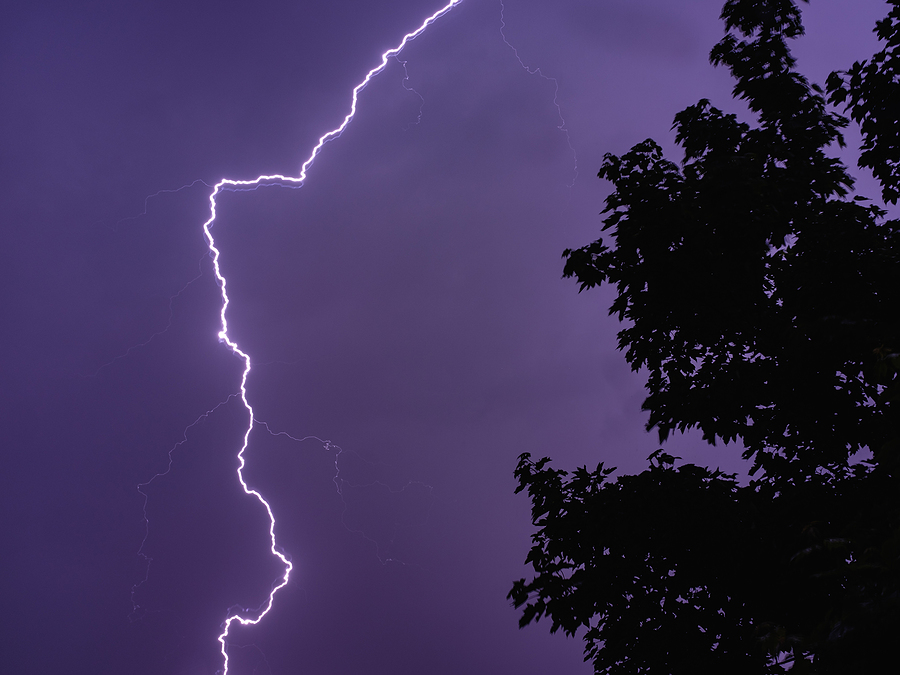Lightning strikes can be devastating to trees, causing irreparable damage and even death. But there are steps you can take to protect your trees from a lightning strike. With some simple tree care practices and proper tree service, you can help ensure that your trees stay safe no matter what the weather brings.
In this blog post, we’ll explore how to effectively protect your trees from lightning strikes, so read on for more information!

How to Protect Trees Against Lightning Strikes
Routine Tree Care
The first step to protecting your trees from lightning strikes is proper tree maintenance. Make sure that you are regularly pruning, fertilizing, mulching, and watering your trees, as this will help them stay healthy and strong enough to withstand a lightning strike. In addition, make sure that the tree is free from dead or dying limbs and branches. These can easily be ignited by lightning and cause severe damage to the rest of the tree. If cuts on the tree need to be made for any reason, it’s best to contact a professional Indianapolis tree service so they can do it properly without risking any further damage.
Lightning Rods
It’s also important to note that lightning rods can be installed around trees in order to protect them from lightning strikes. These rods are placed near the tree and provide an alternate path for the electricity to travel, redirecting it away from the tree and preventing damage. If you live in an area prone to lightning storms, this may be a great option for protecting your trees.
Weather Forecasting
Finally, make sure that you stay up-to-date on weather forecasts during stormy seasons. If there is a forecast of severe thunderstorms or high winds, take extra precautions to protect your trees by pruning back dead or dying limbs and branches and removing any objects close to the trees which could conduct electricity. Also, if possible, try to keep all people and pets away from the trees during a thunderstorm just in case a lightning strike does occur.
Conclusion
By following these tips and taking the right precautions, you can help protect your trees from lightning strikes. Proper tree care and maintenance is key, as well as having a professional tree service on hand to help with any necessary tasks. If you need more information or advice about how to keep your trees safe from lightning strikes, contact an experienced tree service contractor at Complete Tree Care, today. They’ll be able to answer any questions and provide valuable insight into the best ways to protect your trees.
Remember: Lightning safety isn’t something to take lightly; it’s important to stay aware of weather forecasts and take extra measures when storms are forecasted. With the right precautions in place, you can ensure that your trees remain safe during even the worst of weather.
Tree Removal for Dead or Damaged Trees
When it comes to dead or storm damaged trees, removal is often the best course of action. Not only can dead or damaged trees be unsightly, but they can also pose a danger to your property and those around it. Dead trees are particularly problematic as they are more susceptible to falling during a storm or high winds.
Additionally, they are often home to pests and diseases that can spread to other trees in the area. It’s important to consult with a professional tree service company in Indianapolis to discuss your tree removal options. These actions will ensure the job is done safely and efficiently. So, if you have a tree that’s seen better days, don’t hesitate to take action and have it removed before it causes any more problems.
Complete Tree Care is a top tree service provider serving the Indianapolis region. Contact us today at 317-783-2518 to request more information about our winter tree services in Indianapolis, Indiana. We provide residential and commercial tree services, as well as storm damage tree service.
Related Posts:
Is My Tree Dead or Diseased?
Is it Expensive to Remove a Tree That Fell Over?
What To Do After a Storm Leaves Your Trees with Broken Branches
